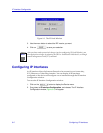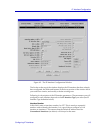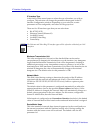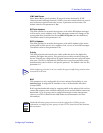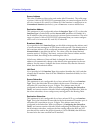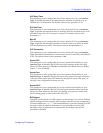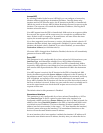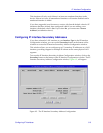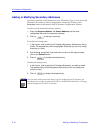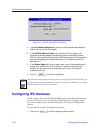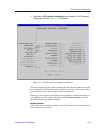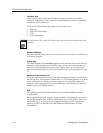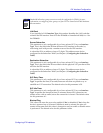
IP Interface Configuration
9-10 Configuring IP Interfaces
The list box at the top of the window displays the Secondary Addresses that have
already been conÞgured; the Þelds and buttons in the lower portion of the
window allow you to add new entries and modify or delete existing ones.
Following is a description of the Secondary Address parameters:
Sequence Number
In this Þeld, enter a number (1 to 15) to identify the secondary address. The
default value is the next number in sequence.
Network Mask
This Þeld is used during routing to determine the portion of the IP address
associated with the subnetwork. The valid entries are 255.0.0.0 to 255.255.255.255
(255.255.255.255 is only valid on a point-to-point interface).
The default value for this parameter is conÞgured automatically to reßect the
appropriate address class for the speciÞed secondary Source Address (see below).
If the secondary Source IP Address is changed, the Network Mask will
automatically change to a default value appropriate for the new address. For this
reason, conÞgure the secondary Source IP Address Þrst, then the Network Mask.
Route Metric Hops
This Þeld speciÞes the routing metric count associated with the secondary IP
address. This is the number of hops (subnet gateways in the overall path over the
internet) associated with this interface (usually zero). During routing, the
interface with the lowest count will be selected.The default value for this
parameter is 0.
Source Address
This Þeld speciÞes the secondary IP address. The valid range of values (1.0.0.0 to
223.255.255.255) guarantees that you cannot conÞgure all 0s or all 1s for a network
ID, node ID, or subnet ID.
Broadcast Address
This is the broadcast address associated with the secondary IP address. This
address is used to send broadcast messages to all LAN hosts on the subnetwork.
The default value of the broadcast address will be conÞgured automatically after
a secondary Source Address or Network Mask is speciÞed (see above). The value
will be the dotted decimal notation result of ÒANDingÓ the binary versions of the
Source Address and the Network Mask, then Þlling in the remaining bits with 1s.
If the secondary Source Address or Network Mask is changed, the associated
broadcast address will automatically change to the default value appropriate for
the new address. For this reason, conÞgure the Source Address Þrst, then the
Network Mask, then the Broadcast Address.



